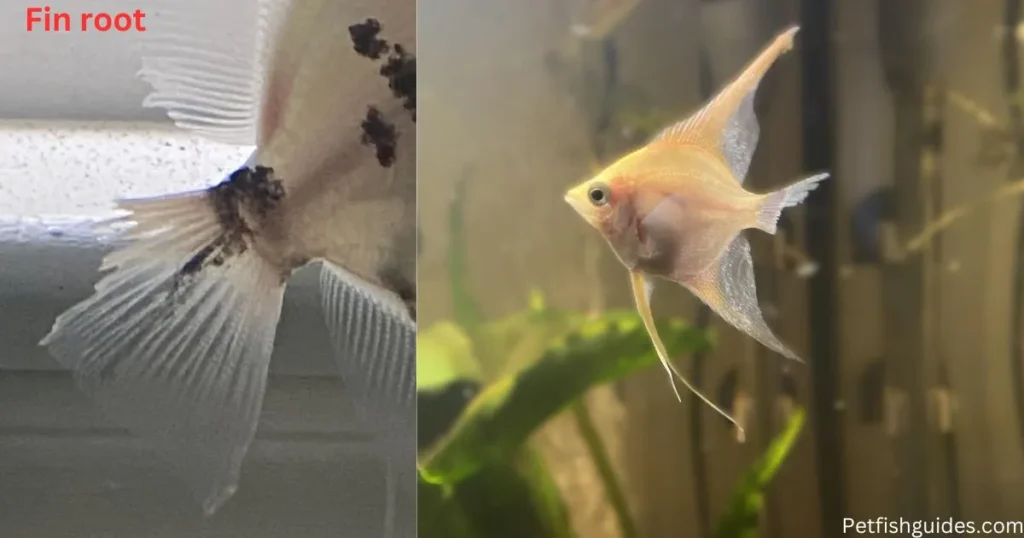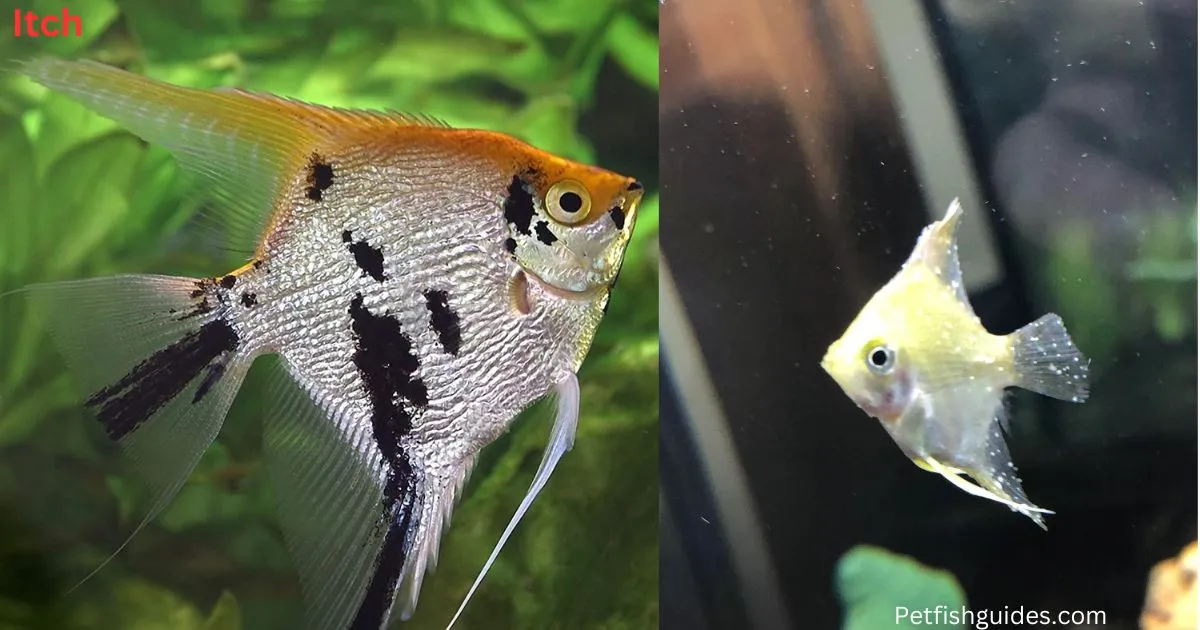The Pterophyllum scalare, commonly known as the angelfish, is one of the most popular freshwater aquarium fish. With their triangular-shaped bodies and large, flowing fins, angelfish add unmatched elegance and beauty to home aquariums. However, these magnificent fish can have a lifespan of over 10 years with proper care. This guide will provide you with a complete overview of pterophyllum scalare care and ideal tank conditions to help maximize the lifespan of your angelfish.

A Brief Overview of Pterophyllum Scalare.
Native to the Amazon River basin in South America, the pterophyllum scalare is a species of freshwater cichlid. Most specimens available in the aquarium trade are captive-bred varieties. Angelfish comes in several color morphs, including silver, black, gold, marble, and more.
Angelfish have laterally compressed bodies that enable them to neatly navigate between plants and decorations. Their most striking feature is the long dorsal and anal fins that resemble flowing angel wings. Mature specimens usually reach 6 inches in length. However, with ideal care, pterophyllum scalare can grow up to 8-10 inches long.
Understanding Pterophyllum Scalare Lifespan.
The lifespan of Pterophyllum Scalare can vary depending on various factors such as genetics, diet, and environmental conditions. On average, these angelfish have a lifespan of 8 to 10 years when kept in optimal conditions. However, with proper care and attention, some angelfish have been known to live up to 15 years.
The Importance of Maximizing Angelfish Pterophyllum Scalare Lifespan.
While most fish only live for a few years, angelfish can have a lifespan of well over a decade. In fact, with optimal tank conditions, some angelfish may even live for 15-20 years. Ensuring your fish live a long, healthy life not only allows you to enjoy their beauty and personalities for longer – it also indicates that you are providing proper care.
Maximizing lifespan involves meeting the angelfish’s needs at every stage, from juvenile to adult. It also requires keeping a close eye on their health and addressing any issues promptly. The effort is well worth it to keep your pterophyllum scalare thriving.
Determining Ideal Pterophyllum Scalare Size.

Pterophyllum Scalare is known for its impressive size, making it a striking addition to any aquarium. These angelfish can grow up to 6 inches in height, with their fins extending even further. When selecting angelfish for your aquarium, it is important to consider the tank size and compatibility with other fish species. Ideally, a tank size of at least 20 gallons is recommended to accommodate the size and swimming needs of Pterophyllum Scalare.
A Complete Care and Size Guide for Pterophyllum Scalare.
Caring for angelfish and allowing them to reach their full-size potential involves providing the right tank setup, nutrition, tank mates, and maintenance. This guide will walk you through all the key elements of pterophyllum scalare care over their lifespan.
Setting Up the Right Tank.
As angelfish grow, they need ample swimming space. A minimum tank size of 29 gallons is recommended for an adult angelfish. For multiple angelfish, provide at least 10 gallons per fish.
Angelfish do best in taller aquariums, as they prefer swimming in the vertical plane. Aim for a tank with a height of 18 inches or more. Planted aquariums are ideal, as angelfish enjoy swimming through dense vegetation. Ensure any plastic plants have soft edges to prevent fin damage.

Maintain water parameters within the following ranges for optimal angelfish health:
- Temperature 76-86°F
- pH 6.0-7.0
- Water hardness is soft to moderately hard
Filtration should be robust, yet gentle enough to not create strong currents that stress angelfish. Canister filters work well. Perform 25% water changes weekly to replenish minerals and remove waste.
Caring for Angelfish Over Their Lifespan.
Special care is needed for angelfish in their juvenile stage, as they are vulnerable. House juveniles in at least a 20-gallon tank with fine gravel substrate to prevent ingestion. Feed 3-5 small meals per day and monitor water quality diligently.
As angelfish matures, you will notice increased growth rates. Adult pterophyllum scalare can grow up to 1 inch per month until they reach full size. Adjust food amounts accordingly. Large angelfish produce more waste, so increase water changes to 30-40% weekly.
In old age, angelfish growth will plateau. Feed more sparingly, but continue providing a varied, nutrient-rich diet. Look out for signs of illness and treat promptly. Lower water hardness and temperatures slightly to reduce metabolic strain.
Feeding for Optimal Health.
Angelfish accept most prepared foods, but a varied diet maximizes health and lifespan. Here are some diet tips:
- Young angelfish need more protein. Feed newly hatched brine shrimp and blood worms.
- Adults need quality flakes and pellets with 40-45% protein content.
- Supplement with frozen or live foods like mysis shrimp and black worms.
- Include plant-based foods like spirulina flakes to provide nutrients.
- Switch up food brands and rotate feedings to prevent nutritional deficiencies.
- Avoid overfeeding, which can foul water and cause obesity.
Recognizing and Treating Angelfish Diseases.
Prevent angelfish illness by quarantining new fish and maintaining excellent water quality. Watch for these common health issues:
Ich (white spot disease): Small white dots cover fish. Treat with elevated heat and aquarium salt or ich medication.
Fin rot: Ragged, deteriorating fins. Caused by poor water conditions. Improve water quality and dose antibiotics.
Swim bladder disorder: Fish struggles to stay balanced. It can be genetic or caused by improper diet. Feed peas and optimize water parameters.
Dropsy: Scales pinecone out. Usually fatal but treat early with Epsom salt baths and antibiotics.
Fungal infections: Cottony growth, lesions on the skin. Use antifungal medications.
A balanced diet is vital for the health and vitality of Pterophyllum Scalare. These angelfish are omnivorous, meaning they consume both plant matter and small aquatic organisms. To meet their nutritional needs, include a variety of foods such as high-quality pellets, flakes, frozen or live brine shrimp, and bloodworms. Feed them small portions two to three times a day, ensuring they consume the food within a few minutes.
Common Health Issues and How to Prevent Them in Pterophyllum Scalare.

Like any other fish species, Pterophyllum Scalare is susceptible to certain health issues. The most common ailments include fin rot, ich, and swim bladder disease. To prevent these issues, maintain excellent water quality through regular water changes and proper filtration. Quarantine new fish before introducing them to the main tank to prevent the spread of diseases. Additionally, a well-balanced diet, stress reduction, and regular observation can help detect and address any health concerns early on.
Compatible Tankmates for Pterophyllum Scalare.
When selecting tankmate, Avoid aggressive or fin-nipping species that may stress or harm the angelfish. It is also advisable to introduce tankmates of similar size to prevent any predatory behavior.
Angelfish do well with similarly-sized, peaceful companions that won’t nip flowing fins. Some compatible tankmates include:
- Tetras
- Mollies
- Swordtails
- Corydoras catfish
- Bristlenose plecos
- Dwarf gourami
Avoid aggressive fish like tiger barbs that may harass angelfish. Introduce any new tankmates slowly and provide ample hiding spots.
Bringing it All Together for a Long, Healthy Life.
Caring for your angelfish requires dedication and close attention to their needs. By setting up the ideal tank, feeding a nutritious diet, and staying vigilant about health issues, you can keep your pterophyllum scalare thriving for over a decade. Nothing beats the reward of seeing these magnificent fish grace your aquarium for years to come.
Follow this complete guide, and you’ll be well on your way to maximizing the lifespan of your angelfish!
Breeding Pterophyllum Scalare: Tips and Techniques.
Breeding Pterophyllum Scalare can be a rewarding experience for aquarists. To initiate the breeding process, create a separate breeding tank with soft, slightly acidic water. Provide flat surfaces such as broad-leaved plants or slate where the angelfish can lay their eggs. The male and female angelfish will engage in courtship behaviors, and the female will lay eggs on the chosen surface. Once the eggs are laid, the parents will guard and tend to them until they hatch. Proper diet and water conditions are essential during this time to ensure the survival and growth of the fry.
Complete Angelfish Breeding Guide..
Troubleshooting: Dealing with Challenges in Pterophyllum Scalare Care.
Despite your best efforts, you may encounter challenges when caring for Pterophyllum Scalare. Some common issues include aggressive behavior, poor water quality, and compatibility problems with tankmates. To address aggression, provide ample hiding spots and rearrange the tank decor to disrupt territorial disputes. Regular water testing and maintenance will help prevent water quality issues. If compatibility problems arise, consider separating the angelfish or rehoming incompatible tankmates.
Conclusion:
Caring for angelfish Pterophyllum Scalare is incredibly rewarding, but does require dedication to meet their needs. By setting up the proper tank size, filtrations, plants, and tankmates, you provide the ideal living environment. Feed a varied, nutrient-rich diet, maintain excellent water quality, and promptly address any signs of illness. Follow this complete guide to help your graceful pterophyllum scalare thrive and live a long, healthy life of over 10 years. Keep a close eye on their growth and make adjustments as they mature. With the right care, you’ll be able to enjoy these magnificent fish for many years to come.
FAQs.
How often should I feed my angelfish?
Feed mature angelfish once or twice per day. Only feed as much as they can consume in 2-3 minutes before uneaten food sinks and deteriorates water quality.
Why did my angelfish Pterophyllum Scalare stop growing?
Angelfish growth can plateau as they reach old age, usually after 7-10 years. Lower the water temperature slightly and feed a bit less to account for a slower metabolism.
Are angelfish aggressive toward other fish?
Adult angelfish can become territorial, especially during spawning. Ensure tankmates are not nippy and have places to hide and retreat if needed.
My angelfish is not eating. What should I do?
Loss of appetite usually signals a health problem. Test water parameters and watch for signs of disease. Consider treating with antibiotics. Offer blanched, peeled peas which can help with digestion issues.
How do I get my angelfish to reach its full-size potential?
Maximize growth by feeding a varied, protein-rich diet, maintaining excellent water quality, providing ample swimming space, and keeping tankmates and tank conditions stress-free. Genetics also plays a role in size.

